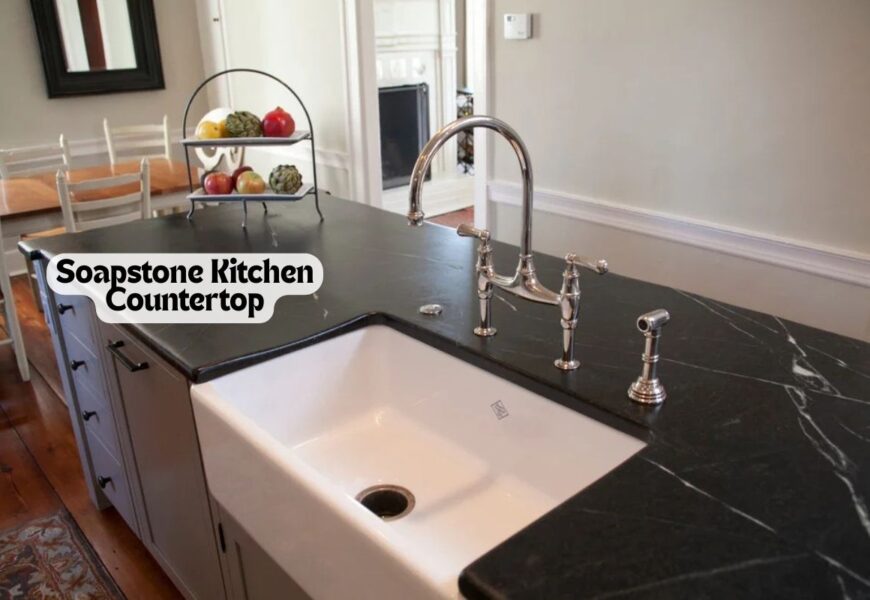Introduction
A soapstone kitchen countertop brings unmatched elegance, durability, and timeless charm to any kitchen. Its smooth texture, natural veining, and subtle color variations make it a favorite among homeowners and designers alike. Beyond aesthetics, soapstone is heat- and stain-resistant, making it ideal for busy kitchens. In this article, we’ll explore the benefits, styles, and design ideas that make soapstone a standout choice. Whether you’re renovating or building from scratch, these insights will inspire your stewart dream kitchen.
What Is Soapstone?
Soapstone is a natural metamorphic rock primarily composed of talc, which gives it a soft, smooth texture and a silky feel. It has been used for centuries in kitchens and homes due to its durability and resistance to heat and chemicals. Available in shades ranging from soft gray to deep charcoal, soapstone often features subtle veining that adds visual interest. Its dense composition makes it less porous than other stones, reducing the risk of staining and bacterial growth. This combination of practicality and aesthetic appeal makes soapstone a timeless choice for kitchen countertops.
Pros and Cons of Soapstone Countertops
A soapstone kitchen countertop offers excellent heat and stain resistance, making it perfect for busy kitchens. It develops a natural patina over time, adding character and charm to any space. While highly durable, it can scratch more easily than harder stones and requires occasional oiling. Limited color options and higher cost are factors to consider when planning your kitchen design.
Types of Soapstone
Soapstone comes in several varieties, each offering unique colors and patterns to suit different kitchen styles. While most are shades of gray, some have subtle green, blue, or brown undertones. The veining and texture can range from soft and uniform to dramatic and bold, giving homeowners plenty of design options. Here are some common types:
1.Tahitian Soapstone
Dark gray with subtle green or blue undertones.
2.Alaska Soapstone
Light gray with soft, uniform veining.
3.St. Stephen Soapstone
Deep charcoal with bold, dramatic patterns.
4.Savannah Soapstone
Medium gray with natural, flowing veining.
Each type offers a distinct look while maintaining soapstone’s durability and timeless appeal.
Incorporating Soapstone in Your Kitchen
Integrating a soapstone kitchen countertop into your kitchen design enhances both style and functionality. They work beautifully on islands, prep areas, and along main countertops due to their heat and stain resistance. Pairing soapstone with complementary materials like wood, metal, or tile can create a balanced, cohesive look. Its neutral tones allow it to fit seamlessly into modern, rustic, or traditional kitchens. Thoughtful placement and coordination with cabinetry and accents ensure that the countertop becomes both a practical surface and a striking design feature.
Pairing Soapstone With Cabinetry and Materials
Soapstone countertops pair effortlessly with a wide range of cabinetry and materials, creating a harmonious kitchen design. Dark or oak cabinets enhance its natural depth, while white or light-colored cabinets provide a striking contrast. Combining soapstone with wood, metal, or butcher block elements adds warmth and texture to the space. Its versatile gray tones allow it to complement both modern and traditional styles. Thoughtful pairing ensures that the countertop stands out while maintaining a balanced and inviting kitchen aesthetic.
Combining Soapstone With Other Countertop Materials
Mixing soapstone with other countertop materials can create a dynamic and visually appealing kitchen design. Pairing it with marble or granite adds contrast while maintaining a natural stone aesthetic. Quartz or polished concrete can provide sleek, modern surfaces that complement soapstone’s soft, matte finish. Using different materials on islands, prep areas, or accent sections allows for functional zoning and creative styling. This combination approach adds depth, interest, and versatility to your kitchen layout.
Soapstone in Kitchen Styles
Soapstone countertops adapt beautifully to a variety of kitchen styles, from rustic farmhouse to sleek midcentury designs. In farmhouse kitchens, they add warmth and timeless charm, especially when paired with wood cabinets and vintage fixtures. Luxury kitchens benefit from soapstone’s subtle elegance and ability to complement high-end appliances and finishes. Rustic or traditional kitchens highlight its natural texture and patina, creating a cozy, lived-in feel. No matter the style, soapstone provides both functionality and a sophisticated aesthetic that enhances the overall kitchen design.
Color and Vein Variations
Soapstone offers a range of colors and veining patterns, allowing homeowners to choose a look that fits their kitchen aesthetic. Common shades include soft gray, deep charcoal, and subtle green or blue undertones, each bringing a unique character to the space. Veining can be delicate and uniform or bold and dramatic, adding visual interest and depth. These natural variations make every countertop one-of-a-kind, enhancing the kitchen’s overall design. Selecting the right color and pattern ensures your soapstone countertop becomes a striking focal point.
Soapstone Kitchen Islands and High-Use Areas
A soapstone kitchen countertop is an ideal choice for kitchen islands and high-use areas due to its durability and heat resistance. It can withstand hot pots, heavy chopping, and daily wear without losing its elegance. Islands featuring soapstone become both functional workspaces and central design elements in the kitchen. Pairing them with complementary cabinetry or contrasting countertops enhances visual interest and flow. Installing soapstone in these key areas ensures practicality while making a lasting style statement.
Embracing the Patina and Natural Aging
One of soapstone’s most unique features is its ability to develop a rich patina over time, enhancing its natural beauty. As it ages, minor scratches and wear blend seamlessly, giving the countertop a lived-in, authentic look. Regular oiling can deepen the color and highlight its subtle veining, though many homeowners appreciate the soft, matte finish that comes naturally. This evolving quality makes each soapstone countertop truly one-of-a-kind. Embracing its natural aging process allows your kitchen to gain character and timeless charm.
Design Inspirations for Your Home
Soapstone countertops offer endless design inspiration, from bold contrasts with white cabinets to pairing with warm wood tones. They can serve as a subtle backdrop or a striking focal point, depending on your kitchen style. Incorporating accents like metal fixtures, colorful backsplashes, or natural stone elements enhances their visual appeal. Thoughtful styling ensures soapstone complements the overall aesthetic while making your kitchen inviting and unique.
Faux Soapstone Options
For those seeking the look of soapstone on a budget, faux soapstone surfaces offer a practical alternative. These materials mimic the stone’s color, veining, and matte finish while often being lighter and easier to maintain. They can be used on countertops, islands, or accent areas without compromising style. Faux soapstone provides an affordable way to achieve the elegance and versatility of natural stone in any kitchen.
Trends in 2025
In 2025, soapstone countertops are trending for their timeless elegance and natural versatility. Homeowners are increasingly pairing them with warm wood tones, bold cabinetry, and mixed-material designs. The focus is on creating kitchens that balance functionality with sophisticated, organic aesthetics. This trend highlights soapstone as both a practical and stylish choice for modern kitchen renovations.
Maintaining Your Soapstone Countertop
Maintaining soapstone countertops is simple but essential to preserve their beauty and longevity. Regular cleaning with mild soap and water keeps the surface free of stains and debris. Periodic oiling enhances the stone’s natural color and brings out its veining. With proper care, soapstone remains durable, functional, and visually striking for years to come.
Other Kitchen Countertop Options
While soapstone is a standout choice, other countertop materials offer unique benefits and aesthetics. Granite, quartz, and marble provide elegance and durability, while butcher block and solid surfaces add warmth and versatility. Polished concrete and terrazzo introduce modern, industrial charm. Comparing these options helps homeowners select the best material to match their style, budget, and kitchen functionality.
Conclusion
A soapstone kitchen countertop combines beauty, functionality, and timeless appeal, making it a versatile choice for any kitchen style. From its natural patina and heat resistance to its ability to complement various cabinetry and materials, soapstone elevates both design and practicality. Whether you prefer a rustic farmhouse look or a sleek modern kitchen, its unique texture and subtle veining create a striking focal point. By thoughtfully incorporating soapstone into your layout, you can achieve a kitchen that is both stylish and enduring.















